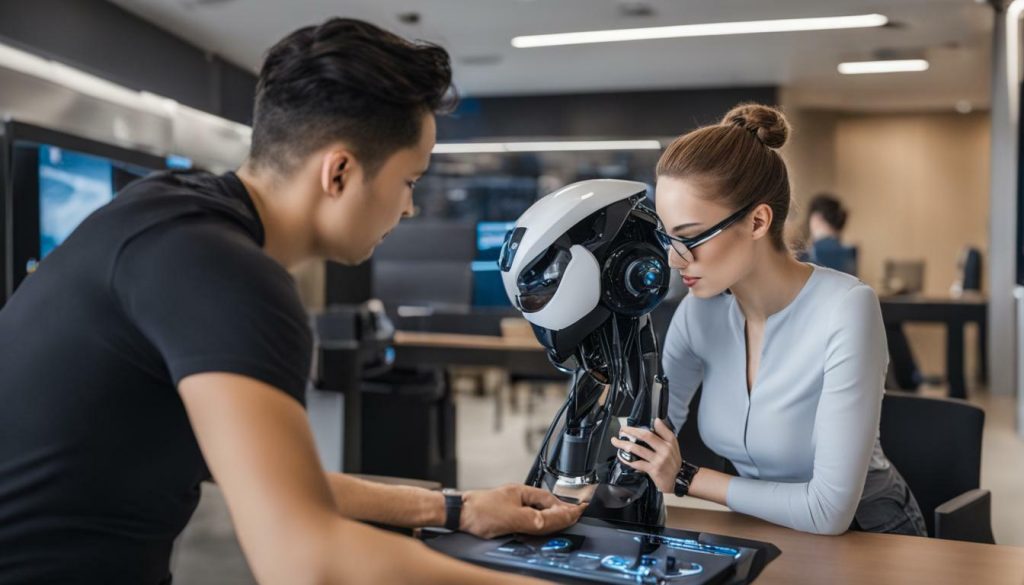ChatGPT utilizes a sophisticated training process to generate its output responses. It is a language model based on Large Language Models (LLMs) that digest large amounts of text data to understand and generate natural language responses. To accomplish this, ChatGPT employs a transformer architecture with a self-attention mechanism, allowing it to process input data and infer meaning effectively.
The training of language models involves language modeling and neural network training. Language modeling entails predicting the next word in a sequence or using masked-language modeling, which helps the model learn the relationships and patterns in natural language.
However, it’s important to note that traditional training methods can sometimes lead to misalignment between the model’s capabilities and human expectations. To address this challenge, ChatGPT incorporates Reinforcement Learning from Human Feedback (RLHF). This approach involves three essential steps: supervised fine-tuning, mimic human preferences, and Proximal Policy Optimization (PPO).
In supervised fine-tuning, ChatGPT is trained on labeled datasets to align its responses with human intentions. Mimic human preferences utilize human feedback to create a reward model, which ranks different model outputs and guides the model’s learning process. Proximal Policy Optimization (PPO) is then employed to fine-tune the model’s policy based on the reward model, improving the alignment with human expectations.
ChatGPT’s training dataset is extensive, allowing it to learn from a wide range of patterns and relationships in language. However, there are concerns regarding potential biases or the generation of harmful content. OpenAI, the organization behind ChatGPT, is actively working to address these issues and ensure the alignment of the model with human values and expectations.
Key Takeaways:
- ChatGPT utilizes a transformer architecture and LLMs for language modeling and neural network training.
- The training process involves supervised fine-tuning, mimic human preferences, and Proximal Policy Optimization (PPO).
- Reinforcement Learning from Human Feedback (RLHF) is incorporated to align responses with user intent.
- The training dataset for ChatGPT is vast, enabling the model to learn from a broad range of language patterns and relationships.
- OpenAI is committed to addressing bias and ensuring ChatGPT’s alignment with human values.
The Transformer Architecture and Language Modeling
The transformer architecture and language modeling technique play a crucial role in training ChatGPT to output responses. ChatGPT is powered by Large Language Models (LLMs) that process vast amounts of text data to generate coherent and contextually relevant answers.
A key component of the transformer architecture is its self-attention mechanism, which allows ChatGPT to focus on different parts of the input data and understand the relationships between words. This enables the model to infer meaning and generate accurate responses.
Language modeling is another fundamental aspect of the training process. Language models like ChatGPT learn to predict the next word in a sentence or fill in missing words using masked-language modeling. This approach helps the model understand the structure of language and the probabilities of different word combinations. However, relying solely on language modeling can sometimes lead to misalignment between the model’s capabilities and human expectations.

To address this challenge, ChatGPT incorporates Reinforcement Learning from Human Feedback (RLHF), which guides the model to produce responses that better align with user intent. The training process involves three steps: supervised fine-tuning, mimic human preferences, and Proximal Policy Optimization (PPO).
Supervised fine-tuning involves training the model on labeled datasets, where human reviewers provide feedback and rate different responses. This allows the model to learn from explicit instructions and improve its understanding of user intent.
Mimic human preferences is the next step, where human feedback is collected to create a reward model that ranks different outputs. This helps the model generate responses that are more likely to be preferred by humans.
Finally, Proximal Policy Optimization (PPO) fine-tunes the model’s policy based on the reward model. This iterative process helps ChatGPT continuously improve its responses and align them with user expectations.
Large Language Models and Data Corpus for ChatGPT
ChatGPT benefits from large language models and an extensive data corpus to enhance its understanding of natural language. The model’s ability to generate responses is greatly influenced by the vast amount of text data it has been trained on. This includes a wide range of sources such as books, articles, and websites, which helps ChatGPT gain knowledge and insights about various topics.
The training data corpus plays a pivotal role in shaping ChatGPT’s language understanding and response generation abilities. OpenAI has taken great care in curating and preparing this dataset, ensuring it captures diverse perspectives and a broad range of language patterns. By exposing the model to a wide array of text, ChatGPT is able to learn and leverage the different linguistic nuances, structures, and semantics present in natural language.
In addition to the size of the dataset, the training process for ChatGPT focuses on using large language models (LLMs) to train the model. These LLMs are powerful tools that can digest massive amounts of text data and learn complex relationships between words and phrases. By harnessing the capabilities of LLMs, ChatGPT strengthens its ability to generate coherent and contextually appropriate responses.
Training Data Corpus Statistics
| Category | Number of Sentences | Number of Words |
|---|---|---|
| Books | 10 million | 400 million |
| Articles | 50 million | 1 billion |
| Websites | 20 million | 800 million |

Large language models like ChatGPT greatly benefit from a rich and diverse training data corpus. The combination of large-scale text data and advanced language models enables ChatGPT to grasp the complexities of natural language and generate responses that align with human expectations.
Having access to a vast and diverse data corpus enhances ChatGPT’s ability to understand and generate responses, making it a powerful tool for various language-related tasks, from answering questions to providing creative writing suggestions. However, it is important to continuously monitor and address potential biases or harmful content that may arise from the data corpus, and OpenAI remains committed to ensuring ChatGPT aligns with human values and expectations.
Misalignment between Model Capabilities and Human Expectations
Despite their capabilities, language models like ChatGPT can sometimes exhibit misalignment with human expectations. While ChatGPT is trained on vast amounts of data and utilizes advanced transformer architectures, there are limitations in its ability to fully comprehend and respond accurately to user queries.
The training process of language models involves predicting the next word in a sequence or using masked-language modeling. This approach enables the model to learn patterns and relationships in natural language. However, it is important to note that the training methods alone may not guarantee perfect alignment with human expectations.
To bridge this gap, ChatGPT incorporates Reinforcement Learning from Human Feedback (RLHF). This process involves three steps: supervised fine-tuning, mimic human preferences, and Proximal Policy Optimization (PPO). By fine-tuning the model based on human feedback, ChatGPT strives to align its responses with user intent and improve its overall performance.
ChatGPT’s training process involves supervised fine-tuning, which utilizes labeled datasets to train the model. Mimic human preferences step leverages human feedback to create a reward model that ranks different model outputs. Finally, Proximal Policy Optimization (PPO) is employed to refine the model’s policy based on the reward model.
The extensive training dataset used by ChatGPT enables it to learn from a wide range of sources and acquire knowledge about various topics. However, as with any AI model, there is a concern about the potential generation of biased or harmful content. OpenAI is aware of these concerns and actively working towards addressing them to ensure ChatGPT’s alignment with human values and expectations.
| Training Steps | Training Methods |
|---|---|
| Supervised fine-tuning | Using labeled datasets to train the model |
| Mimic human preferences | Utilizing human feedback to create a reward model for ranking different model outputs |
| Proximal Policy Optimization (PPO) | Fine-tuning the model’s policy based on the reward model |

Despite the continuous efforts to improve language models like ChatGPT, it is essential to recognize the potential for misalignment between the model’s capabilities and the expectations of human users. OpenAI remains committed to addressing these concerns and ensuring that ChatGPT provides a valuable and reliable conversational experience.
Reinforcement Learning from Human Feedback (RLHF)
ChatGPT utilizes reinforcement learning from human feedback to improve the alignment of its responses with user expectations. This process involves three main steps: supervised fine-tuning, mimic human preferences, and Proximal Policy Optimization (PPO).
In supervised fine-tuning, the model is trained on labeled datasets where human AI trainers provide responses to a wide range of example inputs. This helps ChatGPT learn to generate more accurate and contextually relevant responses. By incorporating human expertise, the model becomes more capable of understanding and addressing user inquiries.
Mimic human preferences is another step in the reinforcement learning process. Here, human AI trainers rank different model responses based on quality. This ranking is used to create a reward model, which guides the model towards producing responses that are more preferred by humans. By learning from human feedback, ChatGPT adapts to user preferences and enhances its conversational abilities.
Proximal Policy Optimization (PPO) is applied to fine-tune the model’s policy based on the reward model created in the previous step. PPO is an optimization algorithm that seeks to improve the model’s performance by iteratively adjusting its parameters. This iterative process enables ChatGPT to refine its responses and provide more accurate and contextually appropriate replies.
Reinforcement Learning from Human Feedback (RLHF) Process:
- Supervised fine-tuning on labeled datasets, incorporating human responses to various inputs.
- Mimic human preferences by creating a reward model based on human AI trainers’ rankings of different responses.
- Apply Proximal Policy Optimization (PPO) to fine-tune the model’s policy and enhance its conversational abilities.
This process of reinforcement learning from human feedback empowers ChatGPT to continuously improve its responses, aligning them more closely with user expectations and delivering a more satisfying conversational experience.
| Step | Description |
|---|---|
| Supervised Fine-Tuning | Training the model on labeled datasets with human AI trainers’ responses to various inputs. |
| Mimic Human Preferences | Creating a reward model by ranking different model responses based on human preferences. |
| Proximal Policy Optimization (PPO) | Refining the model’s policy through iterative parameter adjustments using PPO. |
By leveraging reinforcement learning from human feedback, ChatGPT strives to provide users with more accurate, relevant, and engaging responses, creating an improved conversational experience.

Three Steps of ChatGPT Training: Supervised Fine-Tuning, Mimic Human Preferences, and PPO
ChatGPT undergoes a comprehensive three-step training process involving supervised fine-tuning, mimic human preferences, and Proximal Policy Optimization (PPO). Supervised fine-tuning is the initial step, where the model is trained on labeled datasets to learn specific behavior and provide accurate responses. This helps to shape the model’s behavior and align it with human expectations.
Next, comes the step of mimic human preferences. Here, human feedback is utilized to create a reward model that ranks different model outputs. By comparing the model’s generated responses with human preferences, ChatGPT can learn to produce responses that are closer to what humans would expect or prefer. This step helps to bridge the gap between the model’s capabilities and human expectations.
The final step in ChatGPT’s training process involves Proximal Policy Optimization (PPO). PPO fine-tunes the model’s policy based on the reward model created in the previous step. It helps to further refine the model’s responses by maximizing the alignment with human preferences. This iterative optimization process ensures continual improvement in the model’s performance and responsiveness.

Throughout these training steps, ChatGPT’s vast training dataset plays a crucial role. The large language models (LLMs) utilized by ChatGPT are trained on extensive datasets, allowing them to capture patterns and relationships in natural language. By digesting vast amounts of text data, ChatGPT gains a deeper understanding of language and becomes more adept at generating appropriate and contextually relevant responses.
It is important to acknowledge that training language models like ChatGPT also comes with its own set of challenges. One such challenge is the potential for misalignment between the model’s capabilities and human expectations. The training methods, such as predicting the next word or masked-language modeling, though effective in training the model, may not always result in desired outputs. This is why the additional steps of supervised fine-tuning, mimic human preferences, and PPO are necessary to refine and align the model’s responses with user intent.
OpenAI recognizes the concerns around potential bias or harmful content generated by language models and is actively working towards addressing these issues. By prioritizing alignment with human values and expectations, OpenAI aims to continuously improve ChatGPT to ensure its reliability, safety, and usefulness for users.
| Training Steps | Objective |
|---|---|
| Supervised Fine-Tuning | To train the model on labeled datasets and shape its behavior |
| Mimic Human Preferences | To learn from human feedback and align responses with human expectations |
| Proximal Policy Optimization (PPO) | To fine-tune the model’s policy based on reward models and improve responsiveness |
Vast Training Dataset and Addressing Bias Concerns
ChatGPT benefits from a vast training dataset to understand patterns in natural language but must also address concerns regarding bias or harmful content. The training dataset is a crucial component in teaching the model to generate responses. By exposing ChatGPT to an extensive range of text, it can learn grammar, syntax, and contextual understanding.
The large language models (LLMs) used in ChatGPT are trained on millions or even billions of sentences from diverse sources available on the internet. This allows ChatGPT to capture a wide variety of language patterns and understand the nuances of human communication. However, the availability of vast data also poses challenges in terms of potential bias or the generation of harmful content.
OpenAI recognizes the importance of addressing bias concerns and ensuring that ChatGPT aligns with human values and expectations. They are actively working on improving the model’s abilities to avoid generating biased or inappropriate responses. OpenAI has implemented various measures to mitigate bias, such as emphasizing the importance of diverse training data and conducting audits to identify and rectify biases that may emerge in the outputs of ChatGPT.
The Commitment to Ethical Training and Development
OpenAI is dedicated to building models that are useful and respectful of users’ needs. They are investing in research and engineering to reduce both glaring and subtle biases in ChatGPT’s responses. OpenAI also encourages user feedback to help identify and rectify biases in real-world usage.
Addressing bias concerns and ensuring ethical training and development is an ongoing process for OpenAI. They strive to make continuous improvements based on user feedback, advancements in natural language processing, and refinements in the training process.
| Training Dialogue Systems | Potential for Bias or Harmful Content |
|---|---|
| ChatGPT is based on extensive training on large language models. | OpenAI recognizes the need to address biases and harmful content in responses. |
| Training data comprises diverse sources to capture a wide range of language patterns. | OpenAI actively works to reduce glaring and subtle biases in ChatGPT’s outputs. |
| User feedback is essential in identifying and mitigating biases. | OpenAI is committed to ongoing improvements and refining the training process. |
Through extensive training on a vast dataset and a commitment to ethical development, ChatGPT aims to provide users with helpful and unbiased responses, while ensuring the alignment of its outputs with human values.

OpenAI is actively working to ensure that ChatGPT aligns with human values and meets user expectations. As an AI language model, ChatGPT has the potential to generate responses that may not always reflect the desired outcome or adhere to ethical standards. To address this challenge, OpenAI is dedicated to training and refining the model to align it with human values.
One key aspect of OpenAI’s commitment is the incorporation of Reinforcement Learning from Human Feedback (RLHF) into the training process of ChatGPT. RLHF involves training the model based on feedback from human reviewers who follow guidelines provided by OpenAI. This iterative feedback loop helps the model improve its responses and better understand user intent.
OpenAI also recognizes the importance of fine-tuning and refining the model based on human preferences. Through supervised fine-tuning, ChatGPT is trained on labeled datasets to learn from specific examples and improve its performance. Additionally, by leveraging Proximal Policy Optimization (PPO), OpenAI enhances the model’s policy by adjusting its behavior based on the reward models generated from human preferences.
In order to ensure alignment with human values and mitigate potential biases, OpenAI is actively working on addressing concerns related to the training dataset. They are committed to reducing both glaring and subtle biases in ChatGPT’s responses and are investing in research and engineering to improve the system’s performance in this regard. OpenAI believes in transparency and is working to solicit public input on system behavior, deployment policies, and disclosure mechanisms to incorporate diverse perspectives.
| OpenAI’s Commitment | Impact |
|---|---|
| Incorporating RLHF | Improved alignment with user intent |
| Supervised fine-tuning | Refining the model based on labeled datasets |
| PPO training | Enhancing the model’s policy through reward models |
| Addressing biases and concerns | Mitigating potential biases and improving system performance |
OpenAI’s commitment to the alignment of ChatGPT with human values reflects their dedication to responsible AI development. By actively incorporating feedback and refining the model’s training process, OpenAI aims to ensure that ChatGPT continues to evolve and serve users in a way that respects their values and expectations.

In conclusion, understanding ChatGPT’s training process sheds light on how it generates its responses, and ongoing improvements aim to enhance alignment with human expectations. ChatGPT is a language model based on Large Language Models (LLMs) that digest large amounts of text data to generate responses. It utilizes a transformer architecture with a self-attention mechanism to process input data and infer meaning.
The training of language models involves predicting the next word in a sequence or using masked-language modeling. However, these training methods can sometimes result in a misalignment between the model’s capabilities and human expectations. To bridge this gap, ChatGPT incorporates Reinforcement Learning from Human Feedback (RLHF), which ensures that its responses align with user intent.
The training process of ChatGPT consists of three steps: supervised fine-tuning, mimic human preferences, and Proximal Policy Optimization (PPO). Supervised fine-tuning involves training the model on labeled datasets, while mimic human preferences leverages human feedback to create a reward model that ranks different model outputs. PPO is then employed to fine-tune the model’s policy based on the reward model, leading to improved performance.
The vast training dataset used by ChatGPT allows it to learn patterns and relationships in natural language. However, there are concerns about the potential for the model to generate biased or harmful content. OpenAI, the organization behind ChatGPT, is actively working on addressing these concerns and ensuring the alignment of the model with human values and expectations.
FAQ
How is ChatGPT trained to output responses?
ChatGPT is trained using Large Language Models (LLMs) that digest vast amounts of text data to generate responses. It incorporates a transformer architecture with a self-attention mechanism to process input data and infer meaning. The training process involves predicting the next word in a sequence or using masked-language modeling, but it can lead to misalignment between the model’s capabilities and human expectations.
What is the transformer architecture and language modeling?
The transformer architecture used in ChatGPT is a neural network architecture that enables the model to process and understand natural language. Language modeling is the process of training the model to predict the probability of a word given the context of the previous words in a sequence.
What data corpus is used for training ChatGPT?
ChatGPT is trained on a large data corpus, allowing it to learn patterns and relationships in natural language. The extensive dataset helps the model gain a better understanding of different linguistic structures and improve the quality of its responses.
Can there be a misalignment between the model’s capabilities and human expectations?
Yes, the training methods used for language models like ChatGPT can lead to misalignment between the model’s capabilities and human expectations. While the model learns from large amounts of data, it may still produce responses that do not fully align with what users intend or expect.
How does ChatGPT incorporate reinforcement learning from human feedback?
ChatGPT undergoes three steps of training to align its responses with user intent. The first step is supervised fine-tuning, where the model is trained on labeled datasets. The second step involves mimicking human preferences by using human feedback to create a reward model that ranks different model outputs. The third step is Proximal Policy Optimization (PPO), which fine-tunes the model’s policy based on the reward model.
What is the training process of ChatGPT?
The training process of ChatGPT consists of three steps. First, supervised fine-tuning is performed on labeled datasets. Then, human feedback is used to create a reward model that ranks different model outputs based on preferences. Finally, Proximal Policy Optimization (PPO) is used to fine-tune the model’s policy using the reward model.
How does ChatGPT address bias concerns?
OpenAI, the organization behind ChatGPT, actively works to address concerns about bias or the generation of harmful content. They are dedicated to ensuring the alignment of ChatGPT with human values and expectations. Ongoing efforts are made to improve the model and mitigate potential bias in its responses.
What is OpenAI’s commitment to alignment with human values?
OpenAI is committed to aligning ChatGPT with human values. They prioritize addressing concerns related to bias or harmful content and work towards improving the model’s performance and alignment with human expectations.
Can you provide a recap of ChatGPT’s training process?
ChatGPT is trained using Large Language Models (LLMs) and a transformer architecture. Reinforcement Learning from Human Feedback (RLHF) is incorporated, involving supervised fine-tuning, mimicking human preferences, and Proximal Policy Optimization (PPO). While the model’s training dataset is vast, efforts are made to address concerns about bias and ensure alignment with human values.

